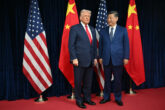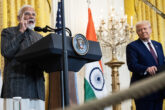April 07, 2014
Aloha Diplomacy: What the U.S.-ASEAN Defense Forum in Hawaii Could Achieve
Secretary of Defense Chuck Hagel walks with defense ministers with the Association of South East Asian Nations in Honolulu, Hawaii April 1, 2014. Hagel held a round table meeting as well as visiting military bases around Honolulu showcasing the aid and support the United States can partner with the ASEAN nations. DoD Photo by Erin A. Kirk-Cuomo (Released)
***
Last week, U.S. Secretary of Defense Chuck Hagel played host to the Association of Southeast Asian Nations’ (ASEAN) Defense Ministers in the first ever U.S.-ASEAN Defense Forum in Honolulu. Secretary Hagel had announced his decision to finally reciprocate ASEAN’s numerous meeting invitations last July, at the International Institute for Strategic Studies’ Singapore-based Shangri La Dialogue – which has become one of the region’s de facto high-level defense meetings.
Although ASEAN Defense Ministers meet with senior U.S. defense officials fairly regularly under the auspices of the ASEAN Defense Ministers’ Meeting Plus (ADMM+), ASEAN Regional Forum (ARF) and in other informal settings, last week’s meeting is significant because it marks the first time the U.S. Department of Defense has taken the lead in inviting its Southeast Asian counterparts to the table as a group, even if informally so as not to invite too much pressure from China.
Taking into account the precedent-setting nature of this U.S.-led forum, here are some highlights from last week’s Honolulu visit that could have a tangible impact on the Southeast Asian regional security landscape in the near future:
1. Increased efforts to coordinate information sharing, especially on humanitarian aid and disaster response (HA/DR). While the highly publicized search for the missing Malaysia Airlines Flight 370 has shown gaps in communication and coordination protocol amongst Southeast Asian countries and in international maritime domain awareness in the region, ASEAN member states have been working towards integrating command and control for many different types of multinational operations. Singapore has already taken the lead in providing platforms for information sharing on transnational criminal activities and maritime and sea lane security, and could potentially take on a leading role once again to formalize means and protocols for coordinating HA/DR operations.
2. More of ASEAN working together instead of working alone. When the Philippines brought its case regarding maritime disputes with China in the South China Sea to the International Tribunal for the Law of the Sea (ITLOS), it did so unilaterally and without conferring with its ASEAN counterparts. However, there has been greater coordination between the Philippines and other South China Sea claimants, crystalized by the February 2014 convening of the 1st ASEAN Claimants Working Group Meeting in Manila. Although there is much work to be done in this area, ASEAN member states are gradually learning that when it comes to dealing with both engaging or pushing back on China, that China may be more responsive when faced with a choice between cooperating or potentially being isolated and out of sync with the group.
3. Better military-to-military relationships. ASEAN militaries already have a strong tradition of participating in military exercises with each other and with the U.S. armed forces, with exercises like Cobra Gold, CARAT, RIMPAC and others serving as calendar fixtures for many Southeast Asian militaries. Expect this military-to-military relationship to expand by firstly becoming more inclusive over time, and secondly, by growing to include other aspects of cooperation, such as more intensive defense industry interaction.
4. East Asia wanting a slice of the pie. With the United States finally playing the role of inviter instead of invitee of high-level ASEAN defense decision-makers, spending a number of days welcoming ASEAN officials with Hawaiian hospitality while showcasing U.S. bases and security assistance (including HA/DR) capabilities, expect East Asian powerhouses like China and Japan to follow suit. We should expect that ASEAN nations will travel to East Asia in the near future for similar high-level exchanges, highlighting the PLA’s or the JSDF’s capabilities and opportunities for cooperation.
With ASEAN’s reputation for preferring a more informal institutional culture, one should not shortchange the significance of this first-of-its kind U.S.-based ASEAN-centered forum. After all, many important ASEAN milestones, including the organization’s founding, have been said to have taken place over a round of golf or at one of Southeast Asia’s renowned beach resorts. With jackets and ties safely stored away, this trip to Hawaii is an important moment for the U.S.’ security relationship with ASEAN as a whole.
More from CNAS
-
Indo-Pacific Security / Energy, Economics & Security
How to Win the Economic War with ChinaTrump's approach to China has run aground, giving Beijing unprecedented advantage in the economic conflict....
By Edward Fishman & Julian Gewirtz
-
America’s Self-Loathing Is a Losing Hand
This article was originally published in The Washington Post.Around 10 years ago, the United States began a historic shift in its grand strategy toward China, abandoning the b...
By David Feith
-
Indo-Pacific Security / Energy, Economics & Security / Technology & National Security
Selling AI Chips Won’t Keep China Hooked on U.S. TechnologyU.S. policy should not rest on the illusion that selling chips can trap China inside the American tech ecosystem....
By Janet Egan
-
Will New Delhi-Beijing Move Beyond Friction Points? | Ex-White Official On India-China Reset
Prime Minister Narendra Modi on Friday said that India and China, as two major economies, must work together to bring stability to the global economic order. NDTV's Gaurie Dwi...
By Lisa Curtis




